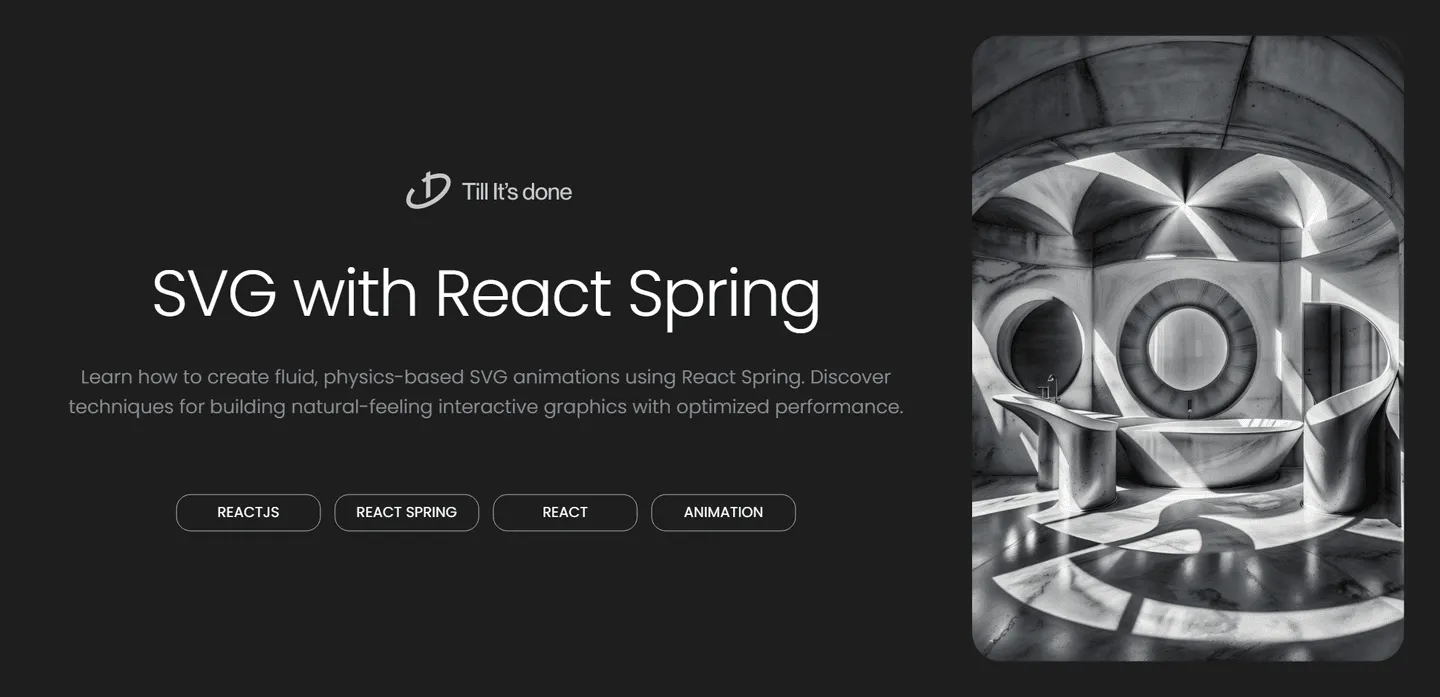- Services
- Case Studies
- Technologies
- NextJs development
- Flutter development
- NodeJs development
- ReactJs development
- About
- Contact
- Tools
- Blogs
- FAQ
Using React Spring to Animate SVG Elements
Discover techniques for building natural-feeling interactive graphics with optimized performance.


Using React Spring to Animate SVG Elements: Creating Fluid Interactions
SVG animations can transform static graphics into engaging, interactive experiences. React Spring offers a powerful way to bring these vector graphics to life with physics-based animations. Let’s explore how to create smooth, natural-feeling SVG animations that will elevate your React applications.
Understanding the Basics
React Spring approaches animations differently from traditional CSS transitions. Instead of using duration-based animations, it employs spring physics - much like how objects move in the real world. This creates more natural-feeling movements that respond dynamically to user interactions.

Getting Started with React Spring and SVG
First, let’s set up our project with the necessary dependencies:
npm install react-springThe magic happens when we combine React Spring’s useSpring hook with SVG elements. Here’s a simple example that animates a circle’s radius:
import { useSpring, animated } from 'react-spring'
function AnimatedCircle() { const [springs, api] = useSpring(() => ({ from: { radius: 0 }, to: { radius: 50 }, }))
return ( <svg width="200" height="200"> <animated.circle cx="100" cy="100" r={springs.radius} fill="#2196f3" /> </svg> )}Advanced Techniques
One of the most powerful features of React Spring is its ability to animate multiple properties simultaneously. Let’s create a more complex animation that transforms both the shape and color of an SVG path:
function MorphingPath() { const [springs, api] = useSpring(() => ({ from: { d: 'M0,100 C0,0 100,0 100,100', fill: '#ff9800', }, to: { d: 'M0,100 C50,150 50,50 100,100', fill: '#2196f3', }, config: { tension: 120, friction: 14 }, }))
return ( <svg width="200" height="200"> <animated.path d={springs.d} fill={springs.fill} /> </svg> )}
Performance Optimization Tips
When animating SVG elements, keep these performance considerations in mind:
- Use
transformproperties instead of absolute positioning whenever possible - Avoid animating complex paths with too many points
- Implement
useCallbackfor animation handlers - Consider using
config.tensionandconfig.frictionto fine-tune performance
Real-world Applications
SVG animations can enhance user experiences in numerous ways:
- Loading indicators
- Data visualization transitions
- Interactive logos
- Morphing icons
- Responsive illustrations
Remember that the best animations are those that serve a purpose - they should guide users, provide feedback, or enhance the overall experience of your application.

Conclusion
React Spring’s physics-based animation system provides a powerful toolkit for creating fluid SVG animations. By understanding its core concepts and following performance best practices, you can create engaging, responsive interfaces that feel natural and intuitive to users.
Remember to experiment with different spring configurations and animation properties to find the perfect balance for your specific use case. The possibilities are endless when combining React Spring’s powerful animation system with the flexibility of SVG graphics.
 สร้างเว็บไซต์ 1 เว็บ ต้องใช้งบเท่าไหร่? เจาะลึกทุกองค์ประกอบ website development cost อยากสร้างเว็บไซต์แต่ไม่มั่นใจในเรื่องของงบประมาณ อ่านสรุปเจาะลึกตั้งแต่ดีไซน์, ฟังก์ชัน และการดูแล พร้อมตัวอย่างงบจริงจาก Till it’s done ที่แผนชัด งบไม่บานปลายแน่นอน
สร้างเว็บไซต์ 1 เว็บ ต้องใช้งบเท่าไหร่? เจาะลึกทุกองค์ประกอบ website development cost อยากสร้างเว็บไซต์แต่ไม่มั่นใจในเรื่องของงบประมาณ อ่านสรุปเจาะลึกตั้งแต่ดีไซน์, ฟังก์ชัน และการดูแล พร้อมตัวอย่างงบจริงจาก Till it’s done ที่แผนชัด งบไม่บานปลายแน่นอน  Next.js สอน 14 ขั้นตอนเบื้องต้น: สร้างโปรเจกต์แรกใน 30 นาที เริ่มต้นกับ Next.js ใน 14 ขั้นตอนเพียงแค่ 30 นาที พร้อม SSR/SSG และ API Routes ด้วยตัวอย่างโค้ดง่าย ๆ อ่านต่อเพื่อสร้างโปรเจ็กต์แรกได้ทันทีที่นี่
Next.js สอน 14 ขั้นตอนเบื้องต้น: สร้างโปรเจกต์แรกใน 30 นาที เริ่มต้นกับ Next.js ใน 14 ขั้นตอนเพียงแค่ 30 นาที พร้อม SSR/SSG และ API Routes ด้วยตัวอย่างโค้ดง่าย ๆ อ่านต่อเพื่อสร้างโปรเจ็กต์แรกได้ทันทีที่นี่  วิธีสมัคร Apple Developer Account เพื่อนำแอปขึ้น App Store ทีละขั้นตอน อยากปล่อยแอปบน App Store ระดับโลก มาอ่านคู่มือสมัคร Apple Developer Account พร้อมเคล็ดลับ TestFlight และวิธีอัปโหลดที่ง่ายในบทความเดียวนี้ได้เลย
วิธีสมัคร Apple Developer Account เพื่อนำแอปขึ้น App Store ทีละขั้นตอน อยากปล่อยแอปบน App Store ระดับโลก มาอ่านคู่มือสมัคร Apple Developer Account พร้อมเคล็ดลับ TestFlight และวิธีอัปโหลดที่ง่ายในบทความเดียวนี้ได้เลย  TypeScript Interface คืออะไร? อธิบายพร้อมวิธีใช้และข้อแตกต่างจาก Type เรียนรู้วิธีใช้ TypeScript Interface เพื่อสร้างโครงสร้างข้อมูลที่ปลอดภัยและเข้าใจง่าย พร้อมเปรียบเทียบข้อดีข้อแตกต่างกับ Type ที่คุณต้องรู้ ถูกรวมเอาไว้ในบทความนี้แล้ว
TypeScript Interface คืออะไร? อธิบายพร้อมวิธีใช้และข้อแตกต่างจาก Type เรียนรู้วิธีใช้ TypeScript Interface เพื่อสร้างโครงสร้างข้อมูลที่ปลอดภัยและเข้าใจง่าย พร้อมเปรียบเทียบข้อดีข้อแตกต่างกับ Type ที่คุณต้องรู้ ถูกรวมเอาไว้ในบทความนี้แล้ว  Material-UI (MUI) คืออะไร อยากสร้าง UI สวยงามและเป็นมืออาชีพในเวลาอันรวดเร็วใช่ไหม มาทำความรู้จักกับ Material-UI (MUI) ที่ช่วยให้คุณพัฒนาแอปพลิเคชันบน React ได้ง่ายและดูดีในทุกอุปกรณ์
Material-UI (MUI) คืออะไร อยากสร้าง UI สวยงามและเป็นมืออาชีพในเวลาอันรวดเร็วใช่ไหม มาทำความรู้จักกับ Material-UI (MUI) ที่ช่วยให้คุณพัฒนาแอปพลิเคชันบน React ได้ง่ายและดูดีในทุกอุปกรณ์  เปรียบเทียบ 3 วิธีติดตั้ง install node js บน Ubuntu: NVM vs NodeSource vs Official Repo แบบไหนดีที่สุด? เรียนรู้วิธีติดตั้ง Node.js บน Ubuntu ด้วย NVM, NodeSource หรือ Official Repo เลือกวิธีที่เหมาะกับความต้องการของคุณ พร้อมเปรียบเทียบ เพื่อการพัฒนาที่มีประสิทธิภาพ!
เปรียบเทียบ 3 วิธีติดตั้ง install node js บน Ubuntu: NVM vs NodeSource vs Official Repo แบบไหนดีที่สุด? เรียนรู้วิธีติดตั้ง Node.js บน Ubuntu ด้วย NVM, NodeSource หรือ Official Repo เลือกวิธีที่เหมาะกับความต้องการของคุณ พร้อมเปรียบเทียบ เพื่อการพัฒนาที่มีประสิทธิภาพ! Talk with CEO
We'll be right here with you every step of the way.
We'll be here, prepared to commence this promising collaboration.
Whether you're curious about features, warranties, or shopping policies, we provide comprehensive answers to assist you.


